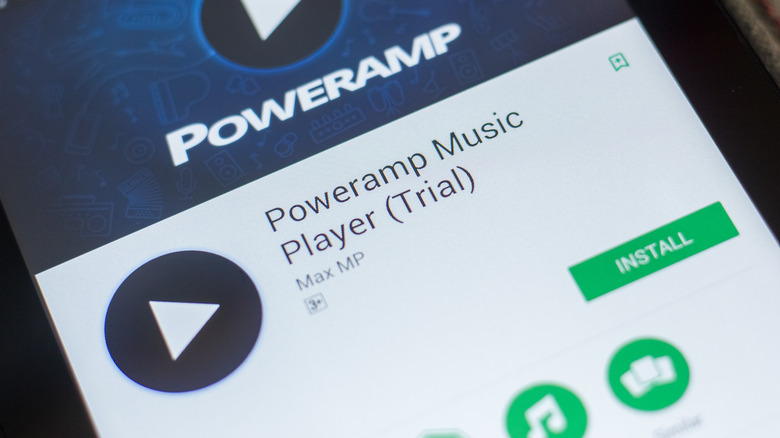
Mike_shots/Shutterstock
When properly configured, equalizers make for a superior listening experience on your Android phone. Some devices just don’t sound clear or loud enough on default settings. By changing your Android phone’s equalizer settings, you can tweak the lows, mids, or highs independently until your music or movies sound just perfect. There are a lot of junk apps out there, though. Many EQ apps are basic graphic equalizers with sliders that give granular control or a simple set of bass and treble knobs. You can filter the audio with quick presets, but these can be lacking.
The way the audio architecture is set up on Android, the OS doesn’t have global support for equalizer settings and effects (via Esper). Third-party equalizer apps rarely work consistently across different audio players. Some custom Android skins have built-in system-wide equalizer controls, but even these aren’t guaranteed to work with every app and hardware configuration.
There are plenty of media player apps with native EQ controls, but not all of them are great. There are EQ apps that claim to work system-wide, but are of mixed quality because of the aforementioned Android audio framework limitations. There are even apps that can import EQ profiles designed for specific models of headphones, customizing the sound quality based on the hardware you’re using, but it can be difficult to tell which ones support most devices and how they perform. We explored each variety of these third-party apps to bring you the five best equalizer apps designed for Android.
Wavelet
First up on the list is Wavelet. Wavelet is a free/paid app that lets you optimize your settings for your earbuds or headphones. The app supports over 3,300 headphone models, which includes many headphones that are worth buying. You can pick your specific headphones from the list and Wavelet will auto-select the best EQ settings for them. The autoEQ delivers sound tuned to the Harman target curve — reported to improve sound on headphones (via XDADevelopers).
If you can’t find your headphones in the Wavelet database, you can import a custom autoEQ profile. The app also lets you manually fine-tune the settings with a 9-band graphic slider. The processing is system-wide and compatible with most media players including YouTube Music, Spotify, Samsung Music, Deezer, and more. However, YouTube, SoundCloud, Tidal, and Amazon Music aren’t currently supported (via GitHub).
The app needs to be activated every time you open the audio player of your choice. Wavelet has an experimental enhanced session detection feature that can apply EQ settings automatically, but it does require some command line tinkering. It features toggles for things like channel balance and limiter (to filter out harsh volume spikes) for free. Advanced features like reverb, bass tuner, and bass booster are available in the full version for $5.49 (via Google Play). Wavelet works on most Android devices, but if you don’t see any toggles or features after installing the app, try tapping the three-dot menu and selecting Legacy Mode.
Flat Equalizer
Flat Equalizer is a free, beautiful, open-source, and system-wide equalizer (via GitHub). It’s not as feature-rich as Wavelet because it lacks headphone-specific tweaks, but once configured and toggled, it works across most apps (including YouTube and Netflix).
Flat Equalizer can be enabled with a single toggle and has a 10-band slider control to make fine adjustments (via Google Play). You can also pick from a variety of presets or load custom profiles. There’s a legacy mode for compatibility issues and a global mix toggle that forces the EQ effects to take over the Android defaults.
If you want to get an extra kick out of the phone speakers, you can boost the volume past the default with the loudness dial. Bass boost lets you push the lows, and with the virtualizer dial toggled, you can create a surround experience. You also get a reverb toggle to simulate a space of your choice — from a small room to a large hall.
The material UI is clean and intuitive and it even has a dark theme. The free version is ad-supported, but you can upgrade to premium with a one-time payment of $19.99 or $0.99 monthly.
Poweramp

Sharaf Maksumov/Shutterstock
Poweramp is an old fan favorite. Designed for audiophiles, Poweramp is a music player with high-res audio support (via Google Play). Other than being chock full of handy features, it also offers advanced EQ support. Most EQ apps are bundled with a graphic equalizer of up to 10 bands, but with Poweramp, you get two equalizers — a graphical EQ that has up to 32 bands (complete with presets) and a parametric EQ which is configured manually. The design gives you finer, more granular control over the audio frequencies and volumes (via Poweramp).
Poweramp also has dials for quickly and independently adjusting the bass and treble volumes and you get controls for stereo virtualization, balance, tempo, and reverb. Direct Volume Control (DVC) cuts through the Android audio API for a better dynamic range. You can also import custom presets for specific audio devices.
The player can process almost every audio file type under the sun (including FLAC and older formats). The UI supports multiple skins, themes, and visualizers, even from third parties. It auto-downloads missing album art for your tracks and auto-sorts them in a dynamic library. Plus, if you use the shuffle feature often, Poweramp has a unique customizable randomizer (via Poweramp). The app is a paid exclusive, but you can download a trial version from the Google Play Store before you drop $6.99 on it.
RE Equalizer FX
If you’re looking for a no-nonsense pro app that gives you total control over your EQ settings and effects, you can’t go wrong with RE Equalizer FX by WiseSchematics. RE Equalizer FX has a unique landscape interface for more convenient access to its 10-band equalizer. The audio engine inside the app filters out distortions and artifacts. You can turn on the FX tab to tweak surround effects, deepen bass, and adjust channel balance. You can even select from 20 preset filters and create 10 custom profiles.
RE Equalizer FX lets you monitor the audio signal in real time. The feature shows a waveform visualizing each filter and tweak in action. Plus, you get plenty more buttons and dials to fine-tune and shape the equalizer profile (via Google Play).
RE Equalizer works with most apps by detecting media playbacks. You can also “lock” it to a single app so audio output from other apps will not be affected. For apps that don’t connect to RE Equalizer FX when their media session starts, there’s also a global output mode that you can use to apply the EQ filters system-wide. It’s not as stable as the dedicated connections for each app, but it works across the board for media players, video streaming apps, and games.
RE Equalizer FX emulates the design and workflow of studio equalizers. It’s incredibly lightweight and doesn’t have ads or collect any data (via Google Play). The app is available on the Play Store for $3.75.
Neutralizer
Lastly, we’ll take a quick look at Neutralizer. Unlike the traditional equalizer apps on this list, Neutralizer takes a more personalized approach to EQ. According to the developer, everyone listens to music differently based on their tastes and hearing, so equalizer adjustments should reflect that (via Google Play). With Neutralizer, you can create custom EQ profiles tailored for your ears and hardware.
Once you install the free app, you’re asked to create a profile for a specific output. It works with on-device speakers and Android Auto, but you’ll get the best results with headphones or earbuds. To create a profile, you can adjust 10 separate frequencies.
Make sure you’re in a quiet room and nothing is playing in the background. Every time you select a frequency (either by tapping the graph or the buttons), you’ll hear a tone. Adjust the volume dial until you can barely hear it (or not at all). Then, move on to the next frequency and repeat. Save and name the profile when done.
It works with most media players when manually enabled, but it’s not compatible with all apps or Android phones. You can create multiple profiles for different audio output devices and users, however, the free version is limited to one profile. Unlocking the premium version of Neutralizer costs $3.99.









